-
Paper Information
- Next Paper
- Previous Paper
- Paper Submission
-
Journal Information
- About This Journal
- Editorial Board
- Current Issue
- Archive
- Author Guidelines
- Contact Us
Architecture Research
p-ISSN: 2168-507X e-ISSN: 2168-5088
2017; 7(4): 168-183
doi:10.5923/j.arch.20170704.05

Survey of Housing Conditions and Improvement Strategies in Okpoko Peri-Urban Settlement of Anambra State Nigeria
Peter Uchenna Okoye1, John Ugochukwu Ezeokonkwo1, Chinwendu Christopher Mbakwe2
1Department of Building, Nnamdi Azikiwe University, Awka, Nigeria
2Department of Quantity Surveying, Nnamdi Azikiwe University, Awka, Nigeria
Correspondence to: Peter Uchenna Okoye, Department of Building, Nnamdi Azikiwe University, Awka, Nigeria.
| Email: |  |
Copyright © 2017 Scientific & Academic Publishing. All Rights Reserved.
This work is licensed under the Creative Commons Attribution International License (CC BY).
http://creativecommons.org/licenses/by/4.0/

Despite several efforts towards addressing the problems of acute shortage of suitable and decent accommodation, slum settlements still persist in urban areas like Onitsha. It is noted that the condition of buildings in which one lives contributes greatly to the overall well being of the person. Therefore, this study surveyed the condition of buildings in Okpoko slum settlement, Anambra State to determine the effects on the general wellbeing of the residents. It also examined the strategies used by the residents to improving the buildings for better quality of life. Being a survey research, questionnaires, interviews, physical observations and photographs were used in collecting the data; which were analysed using Severity Index (SI) and the Relative Importance Index (RII). The study found that majority of the buildings in the area and the surrounding environments are in a very critical and deplorable condition which has significant negative effects on the general wellbeing of the residents. The study identified insecurity, flooding, and crime and immorality as the most apparent effects; and routine sanitation, simple renovation/repair and retrofitting as the most common strategies adopted by the residents in the improvement of condition of the buildings and environment. It then recommended update and full implementation of the UN-Habitat Structure Plan for Onitsha and Satellite Towns which must involve all stakeholders; in addition to enactment of urban renewal law with detailed operational frameworks in Anambra State.
Keywords: Housing Condition, Improvement Strategy, Peri-Urban, Slum Settlement, Upgrading
Cite this paper: Peter Uchenna Okoye, John Ugochukwu Ezeokonkwo, Chinwendu Christopher Mbakwe, Survey of Housing Conditions and Improvement Strategies in Okpoko Peri-Urban Settlement of Anambra State Nigeria, Architecture Research, Vol. 7 No. 4, 2017, pp. 168-183. doi: 10.5923/j.arch.20170704.05.
Article Outline
1. Introduction
- UN-Habitat [1] decried that despite the recognition of everyone’s right to adequate standard of living, including adequate housing by the International Human Rights Law; well over a billion people are not adequately housed. It has also been observed that the world’s population is already more urban than rural, but the social, economic and institutional capacity and infrastructure of urban areas and cities cannot keep up with the rapid rate of urbanisation [2]. Recent UN-Habitat report [3] revealed that in developing countries, 881 million urban residents lived in these poor informal settlements in 2014 as against 689 million in 1990. This represents an increase of 28 per cent in the absolute numbers of slum dwellers over the past 14 years. In 2000, 39 per cent of the urban population in developing countries resided in slums; this declined to 30 per cent in 2014. The percentage of slum dwellers in urban areas across all developing regions has reduced considerably since 1990, but the numbers have increased gradually since 2000 except for a steep rise of 72 million new slum dwellers in Sub-Saharan Africa [3]. The prevalence of slums is highest in sub-Saharan Africa, where slum dwellers represent 62 percent of the urban population [4]. The UN-Habitat [3] further reported that the Sub-Saharan Africa alone accounts for 56 per cent of the total increase in the number of slum dwellers among developing regions between 1990 and 2014. Indeed, the number of slum dwellers in Sub-Saharan Africa has grown in tandem with growth in the region’s urban population. Although the proportion of the urban population residing in slums today is lower than it was some two decades ago, the absolute number of slum dwellers continues to increase [3]. Another UN-Habitat report [5] observed that although 220 million people in the world have moved out of the slum conditions due to the efforts of slum upgradation, the absolute number of slum inhabitants actually increased from 776.7 million to 827.6 million between 2000 and 2010. Accordingly, this implies that there is still a long way to go in many countries, in order to reduce the large gap between slum dwellers and the rest of the urban population living in adequate shelter with access to basic services.Even in Nigeria, Izueke and Eme [6] agreed that rapid urban growth of cities has seriously outstripped the capacity of most cities to provide adequate basic services to their citizens. According to Aduwo, Edewor and Ibem [7] the result has been the proliferation of urban slums in core areas and periphery of Nigerian cities. Jaitman and Brakarz [8] affirmed that a large proportion of the urban poor in developing countries live in urban or peri-urban areas, under conditions of overcrowding, deficient urban and social services, poverty, high exposure to crime and violence, and other social problems.Still in Nigeria just as in other developing nations of the world, slum settlements exist in most cities and urban centres [9]. Apparently, the UN-Habitat report [10] showed that between 1990 and 2010, the Nigerian urban population has increased from 33,325,000 to 78,845,000 with the urban slum population also increased from 25,763,000 to 48,805,000; while the proportion of urban slum population declined from 77.3% to 61.9%. Although the reports of the Office of the Senior Special Assistant to the President on Millennium Development Goals (OSSAP-MDGs) [11] and UN-Habitat [3] indicated that the proportion has further declined to 50.2% in 2014. OSSAP-MDGs argued that it hides the reality of the swelling number of slum dwellers (in millions) in Nigerian cities given that the total housing deficit in 2014 was between 16-18 million units, and the number of cities with a population of one million and above in 2014 was seven, all of which are major factors accounting for slum emergence and rapid development. The Federal republic of Nigeria national housing policy 2012 [12] concurred with this position, but acknowledged that several efforts to addressing the housing situation by successive governments in Nigeria have yielded limited success over the years and today, the nation is estimated to have a total housing deficit of between 17 and 23 million units, while the estimated current demand is put at 37 million houses.Logically therefore, slums are growing in line with acute housing deficit. The more pathetic situation is that the prevalence of slum settlements in Nigeria is continuing, and efforts to reverse the trend, and eventually provide the whole population with decent housing and living conditions is complex, very long-term and seemingly unattainable. The Federal Government of Nigeria Habitat III National Report [13] also agreed that despite several initiatives and programmes by successive Nigerian Governments towards the provision of mass housing development over the years, a large proportion of the populace are unable to access housing, and millions live in sub-standard and sub-human environments characterised by slums, squalor and grossly inadequate social amenities. To this end, the National Housing Policy [12] noted that the problems of housing in Nigeria are enormous and complex, exhibiting marked regional differences, while the rapid rate of uncontrolled and unplanned urban growth are immense. Aligning with the above position, Aduwo et al. [7] noted that more than three-fifths of the total urban populations in Nigeria still live in housing conditions described as slums despite a decline in proportion between 1990 and 2010. This is in concordance with Arimah [14] who also posited that Nigeria is ranked as one of the countries with high slum prevalence. Buttressing further, Olotuah [15] stated that about 75% of dwelling units in urban centres in Nigeria are substandard and the dwellings sited in slums. Affirming this, UN-Habitat [4] revealed that a few countries experienced explosive urban growth with limited or no slum expansion (for instance, India, Indonesia, and Brazil), whereas in others such as Nigeria, slum growth accounts for most of urban growth.In Anambra State and Onitsha urban centre particularly, slum settlements are also spreading and growing. Izueke and Eme [6] agreed that despite all efforts, acute shortage of suitable and decent accommodation especially among the low income groups in urban areas like Onitsha still persist. They [6] further stressed that the poor housing conditions prevail in the majority of urban areas in Nigeria especially in Onitsha and that has posed a serious problem to urban planning. However, based on the definition of slums with regard to structural fitness, accessibility by roads and good drainage and access to water and sanitation, large areas of slums are identifiable in both old and new areas of Onitsha. UN-Habitat [16, 17] identified four main slum settlements within Onitsha metropolis to include: Mammy Market Slum, Otu Slum, Okpoko Slum and Prison Slum. However, Okpoko Slum is the largest among all and possesses the under listed characteristics according to the UN-Habitat [14]:• Haphazard development,• No provision for public facilities and amenities,• Very high density living (439.78 persons per hectare),• Mixed land uses with dysfunctional activities of mixed residential, commercial and small scale industrial uses,• Residential buildings without provision for individual and community pipe water, sewage and electricity,• 95% of the buildings have pit latrines,• High room occupancy ratio of 4.7 per room (in 1988),• One room apartments account for 55% of the houses whereas the average figure for Anambra state is 36%. • Houses are sited on marginal lands and prone to severe flooding and sanitation problems, and• Social problem of harbouring a large population of miscreants and law breakers.There are no doubt the impacts the above conditions would have on the integrity of the buildings in the area. However, due to the informal nature of slum settlements, and cultural, social, and behavioural factors unique to slum populations, little is known about the challenges they face in terms of health, quality of life [18]; and condition of buildings in which they live, which in most cases contributes greatly to the overall wellbeing of the occupants. Although studies [9, 19-22] have been carried out on slum prevalence and conditions in different Nigerian cities, including Onitsha [6], none has ever specifically dealt with the condition in term of suitability and adequacy of the building structure and facilities, and improvement strategies in Okpoko slum settlement, despite its strategic importance. According to Ehigiator [20] slum conditions may differ in different developing nations since problems found in one slum area may not be present in another. Furthermore, Gilbert [23] agreed that the standards differ across the world, and that what is considered to be a slum by poor people in one country may be regarded as perfectly acceptable accommodation by much poorer people in another. On this premise, the 2008 Structure Plans for Onitsha and Environs [16] identified Okpoko as a classic slum. Subsequently, the 2013 National Study of six slums in Nigeria by Foundation for Development and Environmental Initiatives (FDI) [24], commissioned by the Federal Ministry of Lands, Housing and Urban Development also identified Okpoko as a classic slum in the South East zone.From the foregoing, this study is aimed at assessing the condition of building structure and facilities in Okpoko slum settlement to determine their effects on the general wellbeing of Okpoko slum residents. It also examines the strategies used by the residents to improve their building conditions for better quality of life. The choice for Okpoko slum is premised on the fact that it is the largest suburban slum in Anambra State and lies immediately at the outskirt of Onitsha; and it is one of the most densely populated slums in the country, attracting as many as 44,000 people per hectare in 1998 [16, 17]. Most importantly, the physical outlook of the entire settlement of Okpoko suggests a dismal slum settlement that requires urgent intervention. Secondly, UN-Habitat [25] revealed that accurate, localised, standardised and available qualitative and quantitative data on informal settlement and slums and associated learning platforms remain limited. Accordingly, data is often ad hoc and not connected to robust city-wide monitoring and evaluation processes so the dimensions of inhabitants’ lives remain unknown to policy and planning responses.Therefore assessing the suitability, adequacy and conditions of slum housing structure and facilities in Okpoko specifically and Onitsha metropolis in general is imperative for devising appropriate intervention strategies for addressing poverty reduction and achieving sustainable urbanisation in the planning area and a better quality of life. In addition, the study will help to meet part of the objectives of structure plan for Onitsha and satellite towns which is to achieve environmental sustainability in Onitsha and Satellite towns by 2020 through improving the lives of all the people living in slums of Onitsha namely: Okpoko, Otu and Mammy Market and those living in suburban slums through upgrading these slums to provide access to water, sanitation, education, communal facilities, access roads drainages and improved housing and general environment by 2020 [16].
1.1. Study Area
- Okpoko is a peri-urban slum settlement in Ogbaru L.G.A of Anambra State but situated within the metropolis of Onitsha, one of the biggest commercial cities in Nigeria that has witnessed a great influx of people (see figures 1-4). Okpoko Slum is one of the earliest fringe settlements that made up greater Onitsha whose origin has been traced to 1630 [26]. According to Okafor [27] the area known as Okpoko (also including Nkutaku), lies South West of Onitsha City and is bordered on the West by a tributary of the River Niger, on the North by Fegge Community, Onitsha – Enugu Express road, on the West by Habour Industrial Layout, East Niger Residential/Industrial Layout and Niger Bridgehead; and on the East by Onitsha Owerri Road and Obosi Community, and on the South by Odekpe and Atani Communities.
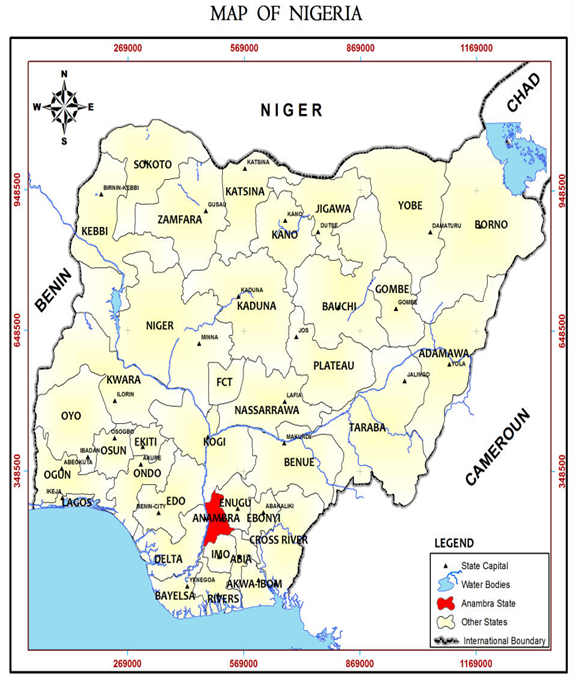 | Figure 1. Map of Nigeria showing the location of Anambra state |
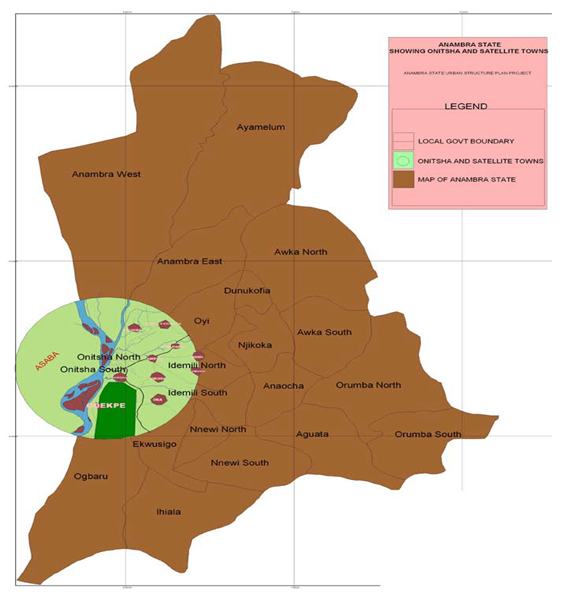 | Figure 2. Map of Anambra State showing Onitsha Metropolis [16] |
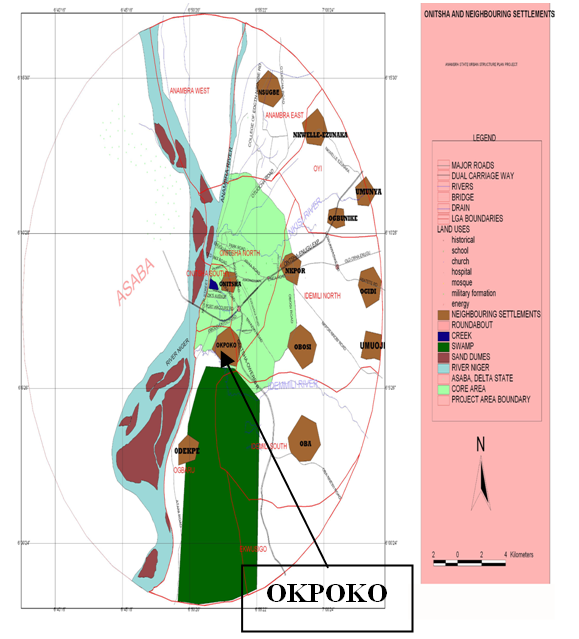 | Figure 3. Map of Onitsha Metropolis showing Okpoko slum Settlement [16] |
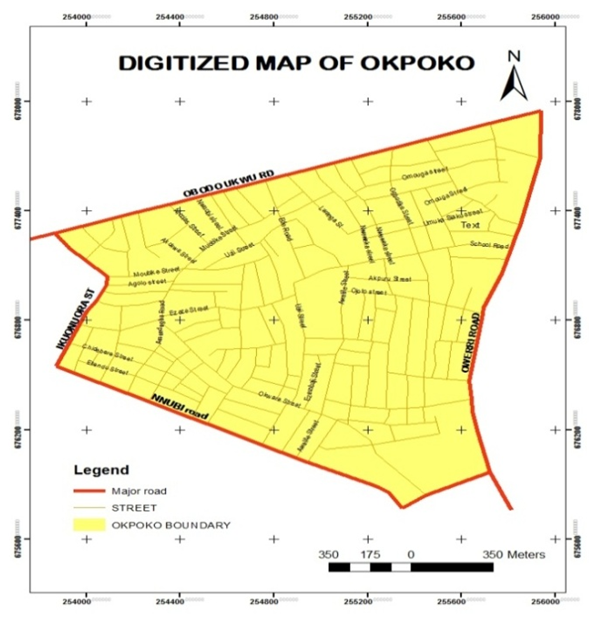 | Figure 4. Map of Okpoko Slum Settlement [29] |
2. Literature Review
2.1. Slum Settlements and Formation in Nigeria
- In general terms, slum settlements are known for their atmosphere of fear and violence [32]. Uwadiegwu [33] described slum areas as neighbourhoods of urban blight and squalid which ranges from simple to complex stages of deterioration. They are usually very congested, with many people sharing a limited area. The shacks are often built with no or very little distance to adjacent structures, forming long rows and large blocks separated by narrow alleyways. Many homes consist of only one room, commonly with the standard dimension 3×3m2, and it is not unusual that large families share such a small space [34]. In Nigeria, UN-Habitat report [35] showed that Nigeria is one of the countries with the worst urban housing situations in the world. Bobadoye and Fakere [9] also averred that the outcomes of poor quality housing in Nigeria have been the proliferation of slums which are characterised by overcrowding, flooding, dilapidated structures, existence of stagnant waste water in generally dirty and unhygienic living environments. To this end, Ehigiator [20] opined that lack of infrastructural facilities in slums are due to the fact that most of these slum areas and informal settlements are not recognised by relevant authorities, as they are not planned for and maybe occupied illegally by residents. Different researchers [36-38] have also adduced many different reasons for slums form and growth in many different parts of the world especially in the developing countries. For instance, Luhar [37] averred that some causes include rapid rural-to-urban migration, economic stagnation and depression, high unemployment, poverty, informal economy, poor planning, politics, natural disasters and social conflicts. In Nigeria, the proliferation of shanty dwellings, squatter settlements and slums in most of Nigeria cities is attributable to a chain of factors which are closely related to the low level of socio-economic and cultural lifestyles of the inhabitants [19, 21]. Bobadoye and Fakere [9] shared this view but further added several factors which contribute to the prevalence of slums in Nigeria to include: scarcity of lands, services and security of tenure; neglect of buildings and their environment which makes them become derelict; poverty and illiteracy; use of sub-standard building materials; poor maintenance culture; congestion; and poor enforcement of sanitation laws.With special reference to Onitsha urban area, Izueke and Eme [6] observed that the filth and infrastructural degradation that have overtaken Onitsha is as a result of poor urban planning. Accordingly, the failure of land sub-division and servicing programmes to keep pace with rapid urban growth has led to wide spread illegal and informal developments, hence the growth of squatter settlements or slum areas, for instance, the housing clusters at Okpoko, Fegge, Woliwo, Odoapku etc. In Okpoko therefore, human interventions and unplanned urban development have led to the formation of slum settlement with inhabitable building conditions and environmental hazards.
2.2. Housing Conditions in Slum Settlements
- The NBS [30] reported that housing conditions, in terms of housing patterns, roofing, walling, flooring materials and other infrastructural facilities that make up the house, play diverse roles in measuring the standard of living/dwelling. The report [30] further argued that a dynamic and buoyant housing condition is a sign of a strong investment, and a veritable indication of future economic growth and social development. But Opoko and Ibem [39] suggested that many of the qualitative deficiencies in housing in most informal settlements can be traceable to the construction process and lack of access to basic services.However, a slum settlement according to Adebayo and Iweka [40] has services and infrastructure far below the adequate or minimum tolerable levels of housing conditions. Karaman [41] observed that housing conditions in such residential neighbourhoods are substandard and deteriorated to the extent that it is unwholesome and a threat to the health, safety, morality and welfare of the inhabitants. Bobadoye and Fakere [9] also agreed that the houses inhabited by slum dwellers are mostly decrepit, overcrowded, in neighbourhoods that are prone to flooding and beset with poor sanitation and shortage of potable water. The notion is also collaborated by Thomas [42] who argued that poor quality housing in informal settlements shows manifestations in hazardous locations; lack of basic services; substandard housing/building structures; overcrowding; unhealthy living conditions (open sewers, uncontrolled dumping of waste and polluted environments) and tenure insecurity. For example, Daniel et al. [22] surveyed the state of urban slums and government's response to the slums problems in some selected cities (Lagos, Port Harcourt, Abuja and Jos) in Nigeria and found that there is acute shortage in the supply of adequate housing for the low-income and poor households across the cities. This is supported by Ibem [43] who argued that urban housing crisis in Nigeria have manifested in homelessness and poor living conditions. As a result, the Nigerian government is confronted with two main challenges. First, is how to improve the housing situation of people living in urban slums; and second is how to assist low-income earners to gain access to decent housing at affordable cost [43]. Therefore, this is a confirmation of the NBS Report [30] which revealed that the overall housing conditions in Nigeria has not improved commensurately with the number of household between 2006 and 2010.
2.3. Housing Conditions in Okpoko Slum
- Surveys of housing conditions have indicated qualitative and quantitative deficiencies in residential accommodation in major towns and cities in Nigeria Izueke and Eme [6]. Undoubtedly, poor housing conditions prevail in the majority of urban areas in Nigeria especially in Onitsha. Despite all efforts, acute shortage of suitable and decent accommodation especially among the low income groups in urban areas like Onitsha still persist which has posed a serious urban planning problem. Specifically, Okafor and Onuohah [44] pointed out that Onitsha metropolis is generally crowded with poor housing structures that are most disorderly located. They further stated that the city has now grown and developed in an unplanned manner resulting in the deterioration of the values of the property and social status of the estate environment.In Okpoko therefore, it can be argued that the housing quality and value in the area is very low due to low quality materials used for construction, the inadequate technology, as well as poor planning standard of housing handling of the building components. Emelumadu et al. [45] confirmed that the urban slum, Okpoko is characterised by low cost buildings. Ofong [46] equally revealed that Okpoko slum residents rely on untreated water with about 27.1% of them using wells and 46.9% relying on boreholes. She further revealed that about 67.5% of the residents dump their refuse in the open air thereby causing more health hazards. Notwithstanding, the more recently erected buildings in the area tend to be more habitable than the ones built much earlier. This is in line with Alao [47] who averred that there is a correlation between relative habitability of housing and their ages. Therefore, this shows that in Okpoko, the level of technology of buildings construction in the area is yet to catch on with the modern age.
2.4. Slum Improvement Strategy and Management
- Slum management and improvement entail the prevention, control and upgrading of slums [9]. The UN-Habitat [48] affirmed that slum upgrading and prevention policies have helped reduce prevalence in urban areas. Interestingly, the Millennium Development Goal (MDG) goal 7 centres on ensuring environmental sustainability. Target 11, of the MDG 7; focus on achieving a significant improvement in the lives of at least 100 million slum dwellers by 2020 [49]. Achievement of this goal and target no doubt requires appropriate slum improvement strategy and management. So far, efforts toward achieving the Millennium Development Goals (MDGs) in the area of slum improvement have resulted in approximately 200 million additional city dwellers to gaining access to clean water, adequate sanitation, and durable housing [50]. Notwithstanding, the net growth of slums continues to outpace the improvement [51]. The current UN-Habitat reports [3, 5, 52] revealed that the number of people moving into slums is increasing.Therefore, Andrade et al. [53] argued that informal settlements have become complex forms, where the social and environmental problems are major challenges for the government and the population for decades. In order to find ways to include them in the urban environment of the formal city, and to improve the quality of life of its inhabitants and minimise environmental impacts caused by the land occupation without infrastructure there is need for slum improvement. Jaitman and Brakarz [8] agreed that improving the quality of life in informal settlements represents one of the greatest challenges that city governments face, given the high growth projections for most cities in developing countries. However, Arimah [14] contended that any attempt at improving the lives of slum dwellers and providing alternatives to new slum formation in African countries, must be preceded by a proper appreciation of the factors that underlie the formation and proliferation of slums. On this strand, Sticzay and Koch [54] opined that the fundamental issue in urban development and slum upgrading is related to the growing number of urban residents and how housing and infrastructure services can be financed for the future urban generations.To ensure sustainable urban development, a number of slum improvement measures have been adopted and implemented over the last fifty years in many developing countries [55]. Arimah [14] agreed that over the past five decades, authorities in African countries have adopted several strategies to tackle the problem of slums and informal settlements. These approaches include benign neglect; repressive options such as forced eviction and demolition; resettlement or relocation; slum upgrading programmes; and most recently, the adoption of enabling strategies. Arimah [14] added that these approaches have evolved over time, and many are still being implemented despite their failure to find lasting solutions to the formation and proliferation of slums and informal settlements. Furthermore, other widely recognised options that may be adopted range from rehabilitation, renovation, economic revivification and preservation [9]. However, Sietchiping [56] chronicled these policy measures to include: Laissez–Faire Attitude (1950s–1960s), Site and Service Scheme (1970s), Upgrading Strategies (1980s), Security of Tenure and Enabling Approach to Slums (1990s), and Cities without Slums Action Plan (2000s).Meanwhile, Bello [57] found the two basic approaches that are most popular in slum management to include: preventive and curative measures. For Charumitra et al. [58], slum management does not only include preventive and curative measures, but also punitive approaches which involve eviction of slum dweller often forcefully; and sometimes relocation within city on another site but most of the time at outskirts of the city without any assistance. However, Bobadoye and Fakere [9] argued that preventive measures taken to forestall the emergence of slum settlements or at least curtail squatting activity are the most desirable option, and maintained that where a slum settlement has evolved with its associated problems, adopting appropriate curative measures becomes imperative. Bobadoye and Fakere [9] advised that cognisance should be taken of the socio-economic implications of the options to be adopted. Regrettably, Charumitra et al. [58] observed that preventive or proactive approach that could address the formation of slums is still in its toddler stage.To this end, different governments and organisations have undertaken several approaches to deal with the problem of slum improvement and management. Even Kvarnström [34] acknowledged that various organisations are involved in slum upgrading projects in order to meet the accelerating demand of low cost housing, and to improve the living conditions in informal settlements. But according to Luhar [37], the strategies tried to reduce and transform slums in different countries, with varying degrees of success, include a combination of slum removal, slum relocation, slum upgrading, urban planning with city wide infrastructure development, and public housing projects. Kvarnström [34] contested that some are small-scale, community initiatives carried out with support from Non Governmental Organisations (NGOs), while others are large-scale, governmental programmes. While, a World Bank study [59] broadly categorised these approaches into adaptive and proactive strategies, an earlier study by the World Bank [50] suggested three options namely: eradicating the slum and relocating residents, clearance and redevelopment; and slum upgrading. Thus, from the forgoing, four typical responses to slums in urban areas are identified. They include: Forced Evictions (whose basic ideology is slum clearance enforced through violent forced evictions and large scale slum demolition, without the offering of any alternative or choice to the populations displaced); Clearance and Relocation (this involves the removal of slum residents from the central city to resettlement sites that are usually miles outside urban areas); Clearance and on-site redevelopment (this involves temporarily moving the slum residents, then clearing the land, and finally building new housing for them on the same site); and Comprehensive Upgrading in place (consists of improving the existing infrastructure and facilities up to a satisfactory standard, and often addressing issues of tenure). However, Mureithi [60] identified three approaches to slum upgrading but acknowledged that each have specific challenges while some are common. But at its basic level, Turley et al. [61] opined that in situ slum upgrading involves improving the physical environment of the existing area, such as improving and installing basic infrastructure like water, sanitation, solid waste collection, electricity, storm water drainage, access roads and footpaths, and street lighting, as well as home improvements and securing land tenure. At its most comprehensive however, slum upgrading consists of physical, social, economic, organisational and environmental improvements undertaken cooperatively and locally among citizens, community groups, businesses, and national governments and city authorities [62].However, it usually begins with a survey of actual conditions followed by the planned rationalisation of layouts of individual plots (land readjustment) in order to enable the introduction of streets and land required for the infrastructure and services. This is combined with some means of ensuring security of tenure (regularisation). While slum upgrading is the main component of the Global Housing Strategy addressing the housing situation in existing areas of cities [63]; to be successful, the process must be community-driven and fully participatory. In all, slum upgrading programmes should comprise a wide range of interventions. On the one hand, there are integral programmes, in which combined interventions take place to improve the living conditions of slum dwellers (the so-called integral approach). According to Jaitman and Brakarz [8] these interventions usually include infrastructure works, provision of urban services, activities in education and health, and community development. Consequently, UN-Habitat [3] proposed a strategy that puts housing at the centre of the new urban agenda meaning at the centre of urban policies and at the centre of cities. This relates to the slum upgrading strategy. An incremental approach to slum upgrading can achieve this, providing adequate housing for low-income urban residents in areas that, in most cases, are already located close to city centre. According to UN-Habitat [3] this strategy will address the social and spatial implications of “housing at the centre” while linking with broader urban renewal strategies for planned city-infill and local economic development, and meeting the density, diversity and mixed-use requirements. The UN-Habitat [48] even adopted slum upgrading as one of the most proactive, pragmatic and effective ways of achieving MDG 7 Target 11, and improving the lives of around 100 million slum dwellers around the world by the year 2020.While some countries such as Brazil, Egypt, Mexico, South Africa, Thailand, and Tunisia have recorded success due to the political commitment to large-scale slum upgrading and urbanisation programmes, including legal and regulatory reforms in land policy and land regularisation programmes [64]; in Africa, different governments have adopted different measures in dealing with the problems of slums and informal settlements [20], and some of these projects provide new accommodation that is unaffordable to many low income households, thereby failing its true cause [34]. On this premise, ambitious interventions to improve the plight of slum dwellers remain unsuccessful in many countries due to ill-conceived policies, ‘brick and mortar’ or ‘public works’-oriented development models, unrealistic regulatory framework and non-participatory planning and implementation process, approaches characterised by bottom-up and community-centric planning and implementation, incremental norms and standards, and building up of social and human capital resulted in improvement of quality of life and livelihoods of urban poor living in slums and squatters [65]. Despite the scenarios above, it is not clear what the best practices are for these upgrades as the currently applied and ongoing interventions by different agencies in slum improvement range from small, single-sector interventions to integral, multi sector slum upgrading programmes. Even though the UN-Habitat [66] noted that the goal of slum improvement can only be achieved through the concerted efforts of all involved stakeholders, reassuring the goodwill of the authorities, the engagement of the concerned communities and the better understanding of the urban poverty problem by the general public. This is also in line with the tenet of Social Development Goals (SDGs) [67] Target 11.1 which projected access to adequate, safe and affordable housing and basic services and upgrade slums by 2030.On the contrary, Daniel et al. [22] contended that what are being practiced in Nigeria are eradication of slum settlements through force eviction and the demolition of houses, and stressed that this approach is a clear contravention of the conventions which emphasis the use of adaptive approach as against the demolition of slums. Based on this, Agbola and Jinadu [68] and Umeh [69] averred that this strategy had failed to provide low-income residents with decent and affordable housing. Aduwo et al. [7] attributed this failure to the lack of adequate understanding of the strategies to combat the deteriorating housing situation among low-income urban residents and the top-down approach to social housing provision. This is affirmed by the UN-Habitat [36] who stated that slum clearance programmes in Nigeria have suffered from inadequate funding and a lack of suitable land to relocate displaced persons. But in Okpoko specifically, UN-Habitat [16, 15] noted that the Federal, State, and Local Governments, NGOs, and international donor agencies have been involved in improving conditions in the major slum area of Okpoko. The State Town Planning Department in the Ministry of Works framed a development scheme for Okpoko in 1976. The World Bank undertook an Okpoko slum-upgrading project in 1981, jointly with Onitsha Local Government and Anambra State Government [14, 17, 70]. The project was described as a huge failure, and the conditions that necessitated it have since worsened, despite the good intentions of government to improve the living conditions of residents in the slums through these programmes. Presently, Okpoko has no donor-funded projects, but a few NGOs, including church organisations, are currently engaged in social development in the area, particularly with the large number of widows. The Okpoko Community Development Union is also working within the community to make it liveable [16, 17]. Unfortunately, there is no approved land use master plan that covers slums areas such as Okpoko, and there is also no security of tenure for people living in Okpoko [16, 17].Having linked the poor urban planning and slum emergence in Onitsha metropolis which includes Okpoko, Izueke and Eme [6] suggested ways to improve urban planning in Onitsha city to include; proper articulation and implementation of planning policies and programmes to address future influx of people in Onitsha urban area; urban renewal and slum clearance programmes; imposition of a moratorium on residential developments in urban areas and most importantly, governments’ commitment to tackle the multifarious problems of urbanisation and urban planning our urban areas. However, UN-Habitat [62] informed that the broader and more integrated the approach the more successful it is likely to be. Similarly, a city-wide approach towards slum upgrading is a more sustainable alternative to piecemeal improvements, providing a programmatic way of addressing the challenge of slums and informal settlements in a city aiming at the physical, social, juridical and economic integration of all slums into the official planning and urban management systems that govern the city [71].
3. Methodology
- For the purpose of this study, the design of study is a survey research. The survey research means the collection and analysis of responses of large samples of people to polls and questionnaires, designed to elicit their opinions, attitudes and sentiments about a specific topic. The researcher used selected sample from the population to discover the relative statistical distribution of selected sample, of the population. The sample frame for this study comprises all the households in Okpoko. However, in line with the objectives of this study, the focus is on the household units and the housing (building) conditions and strategies employed by the slum residents in improving the conditions of the buildings and environment.According to the UN-Habitat [16] the population of Okpoko was 128,417 in 1998 and the population averagely grows at 2.83% growth rate. This growth rate was also recommended by National Population Commission for Anambra State and used by the Anambra State Bureau of Statistics [72] and UN-Habitat [16] for population projections in the state. Therefore, in 2017, Okpoko population would have been increased exponentially based on this growth trend. The population of Okpoko in 2017 can be computed using Malthusian growth model. This model predicts an exponential increase in the population with time. The equation is given as:
 | (1) |
 | (2) |
 | (3) |
 Given that the number of households in the study area is 30,881, the final sample size (n1) is then 384; and since n0 is less than 5% of the population (384 < 5% of 30,881). This number also represents the number of households that will be selected for the study. Whereas a household consists of a person or a group of persons living together usually under the same roof or in the same building/compound, who share the same source of food and recognise themselves as a social unit with a head of household [75, 76].However, a multi-stage sampling technique was employed in choosing the desired samples (number of households). In this case, samples are selected in stages (i.e. selecting the buildings to be studied first and then the households). Firstly, simple random sampling was used in selecting the buildings, and secondly, a systematic sampling technique was used in choosing the households. In this case, samples were obtained by selecting one unit on a random basis and choosing additional elementary units at evenly spaced intervals or natural sequence until the desired number of units was obtained. Since each building in the study area accommodates approximately 6 households [26], 3 households were systematically selected from each chosen building. In all, a total of 128 buildings and 384 households were selected and studied.Meanwhile, data were collected through structured questionnaire personally administered to the heads of the selected households or their representatives. Due to the nature of the study, interviews, physical observation of the buildings, and taking of still photographs were carried out to complement and validate the credibility of the result. Thus, still photographs depicting housing characteristics and conditions, surrounding environments, materials used in construction and solid waste disposal were taken. Accordingly, a total of 384 questionnaires were administered to the selected respondents that represent each of the selected households and 377 retrieved and found useful. This corresponds to response rate of 98.18%. Meanwhile, permission was sought and obtained from the President-General of Okpoko community and all the participants gave their informed consent for inclusion before they participated in the study.Nevertheless, respondents were asked to indicate the state of the conditions of buildings they live in based on certain identified elements in the building. They were also asked to rate the severity of identified negative effects of the conditions of buildings based on their influence on the environment, socio-economic and general wellbeing of the residents. Lastly, the respondents were asked to rate the strategies used in improving the conditions of the buildings based on their frequency of use in the area. All these were rated on a 5-point likert scale, where 1 = Least critical/severe/often and 5 = Most critical/severe/often. While interview questions focused on the dynamics, housing characteristics and conditions, socio economic issues among others. Furthermore, the Severity Index (SI) and the Relative Importance Index (RII) were calculated based on the respondents’ ratings to determine the severity of the condition of the buildings, the severity of the effects of building conditions on the residents and the importance of the strategies for improving the building conditions in the area. These were ranked based on the index values. Thus,
Given that the number of households in the study area is 30,881, the final sample size (n1) is then 384; and since n0 is less than 5% of the population (384 < 5% of 30,881). This number also represents the number of households that will be selected for the study. Whereas a household consists of a person or a group of persons living together usually under the same roof or in the same building/compound, who share the same source of food and recognise themselves as a social unit with a head of household [75, 76].However, a multi-stage sampling technique was employed in choosing the desired samples (number of households). In this case, samples are selected in stages (i.e. selecting the buildings to be studied first and then the households). Firstly, simple random sampling was used in selecting the buildings, and secondly, a systematic sampling technique was used in choosing the households. In this case, samples were obtained by selecting one unit on a random basis and choosing additional elementary units at evenly spaced intervals or natural sequence until the desired number of units was obtained. Since each building in the study area accommodates approximately 6 households [26], 3 households were systematically selected from each chosen building. In all, a total of 128 buildings and 384 households were selected and studied.Meanwhile, data were collected through structured questionnaire personally administered to the heads of the selected households or their representatives. Due to the nature of the study, interviews, physical observation of the buildings, and taking of still photographs were carried out to complement and validate the credibility of the result. Thus, still photographs depicting housing characteristics and conditions, surrounding environments, materials used in construction and solid waste disposal were taken. Accordingly, a total of 384 questionnaires were administered to the selected respondents that represent each of the selected households and 377 retrieved and found useful. This corresponds to response rate of 98.18%. Meanwhile, permission was sought and obtained from the President-General of Okpoko community and all the participants gave their informed consent for inclusion before they participated in the study.Nevertheless, respondents were asked to indicate the state of the conditions of buildings they live in based on certain identified elements in the building. They were also asked to rate the severity of identified negative effects of the conditions of buildings based on their influence on the environment, socio-economic and general wellbeing of the residents. Lastly, the respondents were asked to rate the strategies used in improving the conditions of the buildings based on their frequency of use in the area. All these were rated on a 5-point likert scale, where 1 = Least critical/severe/often and 5 = Most critical/severe/often. While interview questions focused on the dynamics, housing characteristics and conditions, socio economic issues among others. Furthermore, the Severity Index (SI) and the Relative Importance Index (RII) were calculated based on the respondents’ ratings to determine the severity of the condition of the buildings, the severity of the effects of building conditions on the residents and the importance of the strategies for improving the building conditions in the area. These were ranked based on the index values. Thus,  | (4) |
 | (5) |
4. Finding and Discussion
- Table 1 and plate 1 show the criticality of the conditions of building structures and facilities in Okpoko slum. It reveals that almost all the buildings surveyed are in a very bad and critical condition that requires serious interventions. It shows that the variables under consideration are in a very critical and sorry condition. Although from table 1, the severity index analysis result of all the variables considered shows a very high severity, the conditions of Building services (electrical and plumbing systems), Waste disposal, Housekeeping, Access roads and Ventilation are most critical with severity index of 98.25%, 97.29%, 95.97%, 95.92% and 95.28% respectively.
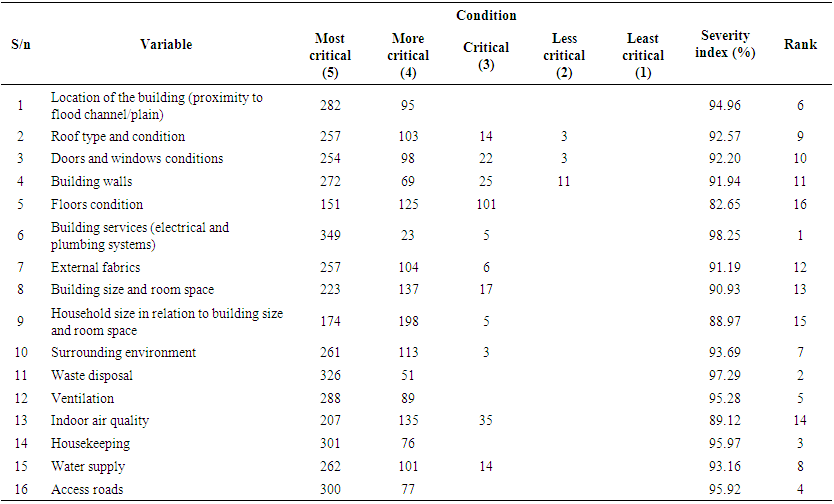 | Table 1. Severity of the Condition of Buildings in Okpoko Slum Settlement |
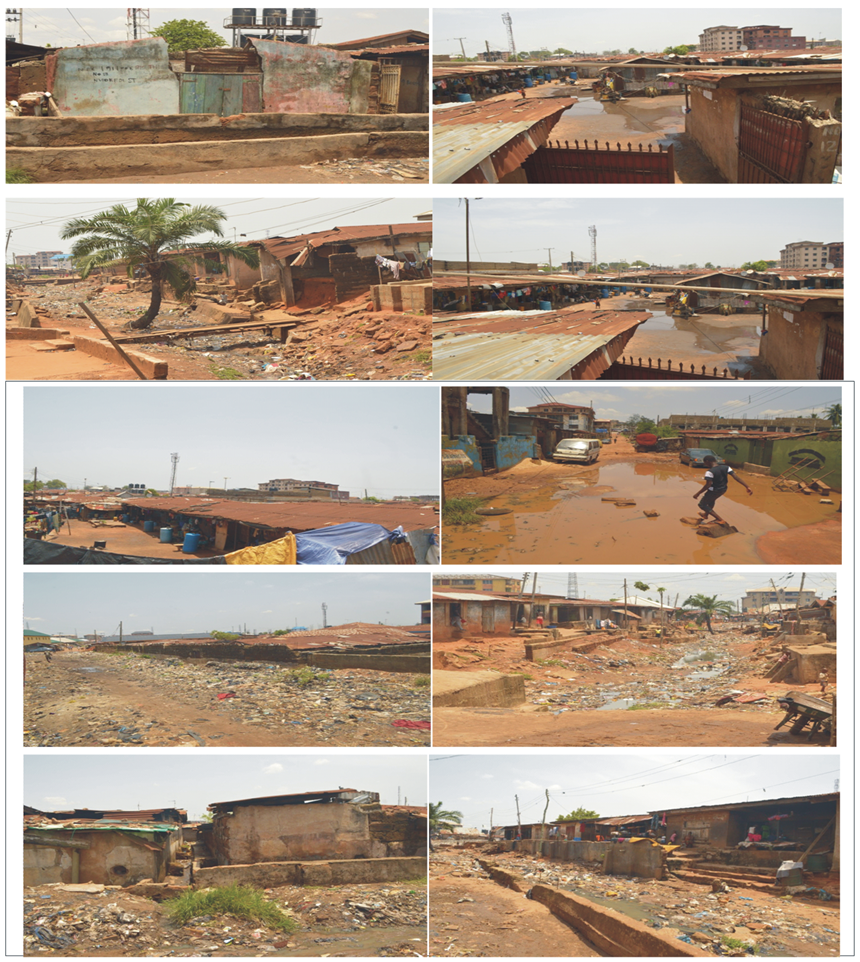 | Plate 1. Different Views of Okpoko Slum Showing the Condition of Buildings and Environment |
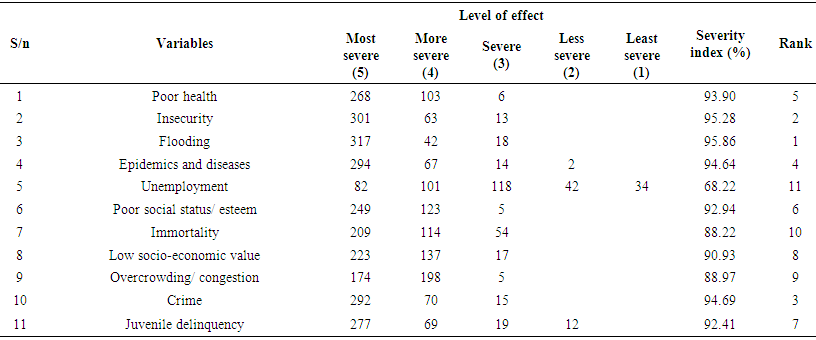 | Table 2. Severity of the Effects of Condition of Buildings in Okpoko Slum Settlement on Residents |
 | Plate 2. Pictures showing Effects of Condition of Buildings in Okpoko Slum |
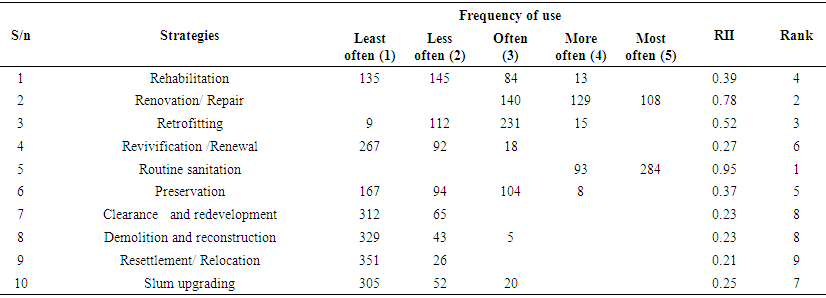 | Table 3. Strategies for Improving the Condition of Buildings in Okpoko Slum Settlement |
 | Plate 3. Kind of improvement being done by the residents to better the condition of buildings in Okpoko slum |
5. Conclusions
- The United Nations Millennium Declaration still reminds us the need for improved living condition of slum dwellers including decent housing. It is also acknowledged that access to adequate housing is a fundamental human right enshrined in the constitution of the Federal Republic of Nigeria. However, the end seems not to be near as slum has continued to spread across the cities and especially in the developing countries as Nigeria with all its negative outcomes. In this regard, this study has examined the conditions of buildings and the surrounding environment in Okpoko, Anambra State and assessed the effects of the conditions of the buildings on the general wellbeing of the residents. It has also examined the strategies employed by the residents in improving their building conditions and environment for better quality of life. The study found that majorly all the buildings in the area and the surrounding environment are in a very deplorable condition which have a significant negative effect on the general wellbeing of the residents. It also revealed that most buildings where people are living are uninhabitable to the level that they lack all necessary facilities for a living house. The study further revealed that while there are a lot of negative effects on the residents due to the condition of the buildings and the environment, the most manifested effects came in the form of insecurity, flooding and crime and immorality. However, it was found that the most applicable strategies used by the residents in improving the condition of their buildings and environment are routine monthly sanitation, simple renovation/repair and retrofitting. It was also revealed that there is no slum upgrading programme currently going on in the area.The significance of this study therefore lies on its findings. The result of this study has a lot of policy implications on the part of the government, non-governmental organisations, community and individual resident. This study has projected the study area as a failed community unworthy of living, but needing serious intervention. Since the issue of slum is a global concern, the result is a call for serious action both from the International Agencies and Communities, Nigerian Government, Anambra State Government, Non-Governmental Organisations, Okpoko Development Union and the residents. It also calls for assessment and reconsideration of institutional and financial framework for slum improvement at National, State and Local level. Thus, there is urgent need to update the profiling of Okpoko slums with a view of generating basic data and information necessary for planning. Diligent implementation of the Structure Plan for Onitsha and Satellite Towns prepared by the UN-Habitat in collaboration with the Anambra State Government is a step in the right direction towards improving the slum condition in Okpoko, Anambra State. Government at all levels should intervene but should involve the stakeholders and the residents through participatory slum upgrading programmes. While there are national laws and policies on urban and regional planning adopted for housing and urban issues, there is a need for wholly new approaches to planning and urban management moving away from regulation and control towards flexible planning instruments that allow authorities to address the real challenges and opportunities posed by urbanisation. Even though the Anambra State Physical Planning Law exists, there is need for enactment of specific law on urban renewal in Anambra State with an operational framework. Finally, a global collaborative movement towards adequate housing for all based on the principles of Human Rights and Inclusion should be strengthened and fortified.
 Abstract
Abstract Reference
Reference Full-Text PDF
Full-Text PDF Full-text HTML
Full-text HTML